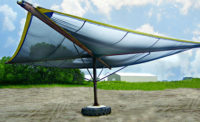Drought and overgrazing have left cattle pasture stands thin and possibly in need of renovation, said University of Missouri Extension livestock specialist Patrick Davis. He urges cattle producers to use summer annuals as a tool to thicken stands or begin the renovation of cool-season perennial pastures.
“Crabgrass, pearl millet and Sudan grass are summer annual grasses that can be seeded now to strengthen the summer grazing rotation,” said Davis. If plans are to renovate cool-season pastures, pearl millet and Sudan grass are good forages to help begin the “spray, smoother, spray” renovation process. These forages provide grazing in the summer months to fill in the cool-season grass slump.
Davis advises cattle producers to check out the MU Extension guide “Warm-Season Annual Forage Crops” and visit with their local MU Extension agronomy specialists to discuss proper seeding and establishment of these summer annuals.
He recommends that cattle producers begin grazing crabgrass at 8 to 10 inches and not grazing lower than 3 inches. Crabgrass can typically be grazed about 30 to 45 days after planting. Begin grazing Sudan grass at a height of greater than 24 inches to prevent prussic acid poisoning.
Since pearl millet does not cause prussic acid poisoning in cattle, begin grazing it at a height range of 18 to 30 inches. Davis urges grazing these forages about 45 to 60 days after planting and not to graze them below 10 inches.
“Nitrate toxicity can be an issue with Sudan grass and pearl millet during summer drought,” said Davis. Consult a local MU Extension livestock specialist for cattle and forage management strategies to reduce potential nitrate toxicity issues.
Lespedeza is a summer annual legume that, if seeded in April, can thicken thin cool-season pasture stands and strengthen the pasture grazing rotation during summer. Davis said this non-bloating legume mixes well with cool-season pastures, tolerates drought and helps dilute fescue toxicosis issues. Though lespedeza is an annual, it will come back each year if allowed to reseed itself. Learn more in the MU Extension guide “Annual Lespedeza”.
For more information on using summer annuals to promote optimum grazing, contact a local MU Extension agronomy or livestock specialist.
Source: University of Missouri Extension

.jpg?height=200&t=1673286212&width=200)


Report Abusive Comment